Overview
To acquire basic and specialized knowledge and essential technology related to animal production science, as well as task setting ability and leadership with internationality in this area, systematic introductions, specialized lessons, scientific English, practical training, etc. We conduct systematic education based on the viewpoints of life science and environmental science.
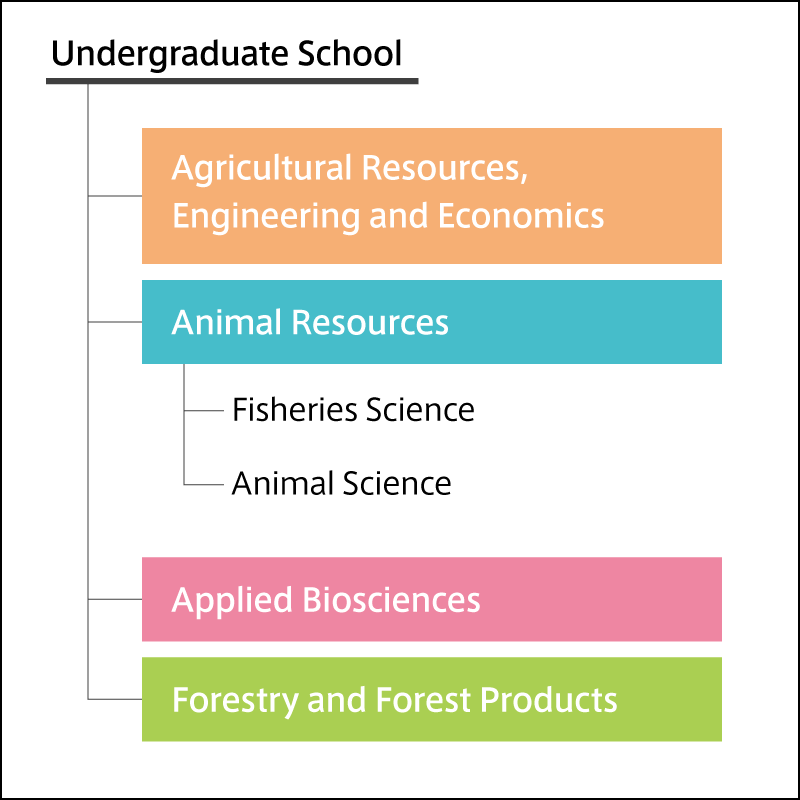
Fisheries Science
The Earth is an Aquatic Planet
With growing populations and increased food demands in the world, fishery resources have a vital role to play in the supply of bioresources. Aquatic organisms living in marine and freshwater environments are important bioresources providing not only food but also unique compounds that can be used as medical and industrial materials for human welfare and environmental conservation. Studies in aquatic biosciences include advanced lectures and various field and laboratory activities in marine biosciences and biotechnology to produce experts on fisheries and related biosciences.
LABORATORY
Marine Biology, Fisheries Biology, Marine Biochemistry, Marine Resource Chemistry, Marine Environmental Science, Aquatic Field Sciencen
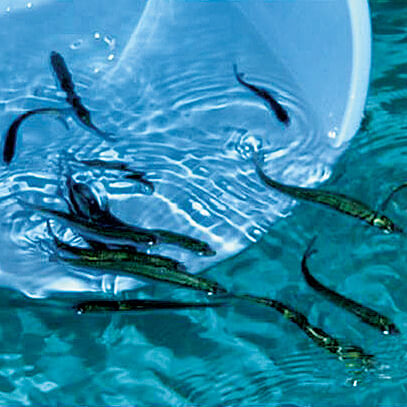
-
More
Sustainable Use of Valuable Fisheries Resources
The most important aquatic food resources in the world are sardines and mackerel. These are referred to as “high-yield, small pelagic fish,” the quantity of which fluctuates greatly in response to long-term changes in the ocean’s ecosystem. In order to sustainably use these fisheries resources, they need to be managed properly. Shedding light on the biological characteristics related to propagation, survival, and growth in different environments is crucial for this. High-yield, small pelagic fish species are very common fish, but there are still many things we don’t know about their natural ecology. By letting these fish spawn and grow in captivity, and researching how they respond to their environment, we have uncovered a number of characteristics that we would not have been able to find out with only research vessels.
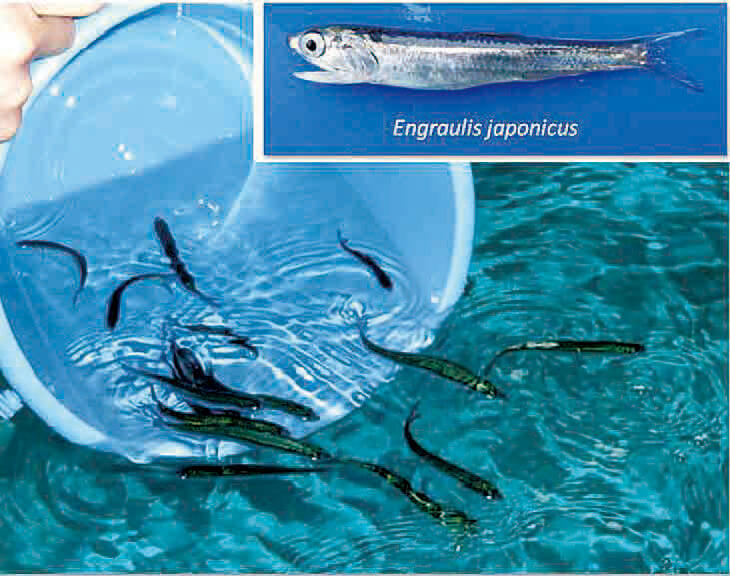
Eliminating Bacteria and Viruses with Complements and Lymphocytes in Fish
Complements are bactericidal proteins that circulate in the blood and work with antibodies. Complement activity is much higher in fish than in mammals and functions in a wide temperature range. White blood cells such as cytotoxic lymphocytes that eliminate virus-infected cells patrol fish blood. Development of a vaccine that uses such lymphocyte functions shows promise in preventing viral diseases in fish, which are difficult to treat with drugs.
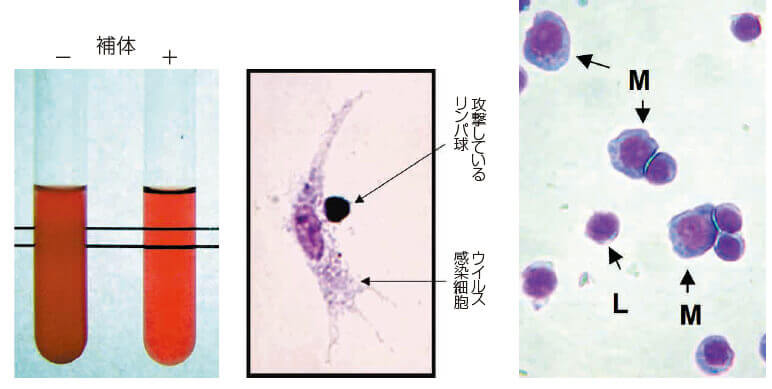
Left: When a complement destroys xenogeneic red blood cells, the hemoglobin is released and the red blood cells disappear, turning the blood transparent.
Right: White blood cells in carp (Cyprinus carpio) blood (M= macrophage, L= lymphocyte)Fluorescence Imaging of Oryzias that Swallowed 200-μm Fluorescent Microplastic
Recently pollution from plastics, and minute microplastics in particular, has become a concern. Using Oryzias as a model, we are conducting research on the pharmacokinetics and impact of such pollutants, and their interaction with absorbed chemicals.
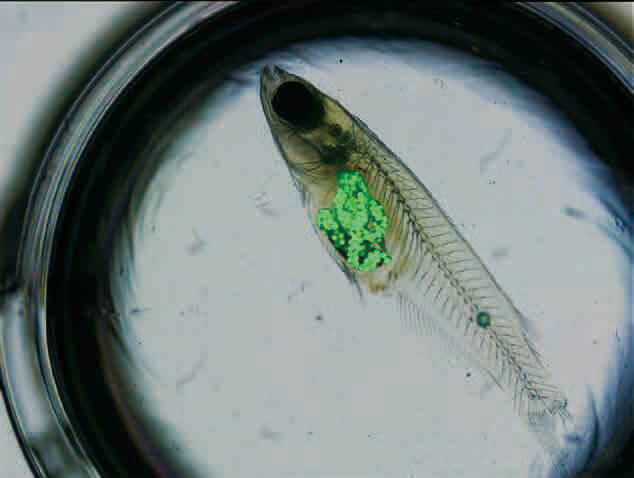
Toxic Algal Red Tide Chattonella
We are researching environmental factors and the effects of pollutants on photosynthesis, proliferation, and other aspects of phytoplankton, which include harmful and toxic species, based on a wide range of perspectives from the genetic to the ecological level.
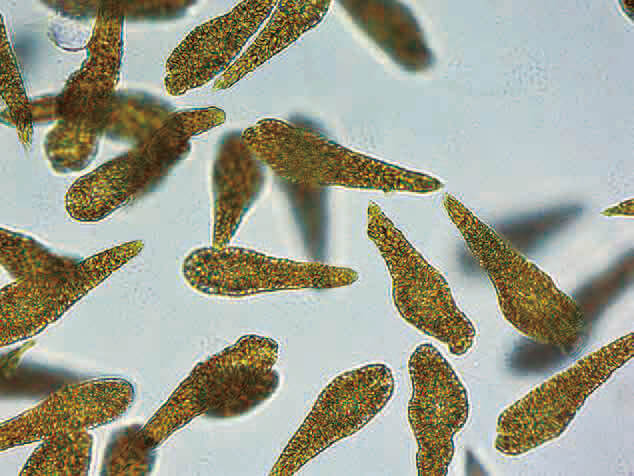
Marine Biology Shows Huge Promise as Frontier Research
For humans to live enriching lives in the future, we need to uncover and utilize new marine genetic resources and their products to contribute to the health and well-being of humans, and to solve energy and other problems. We analyze the unique features and mechanisms of marine microorganisms such as Labyrinthulomycetes, which gets its name from the word labyrinth, with the aim of developing their practical application.
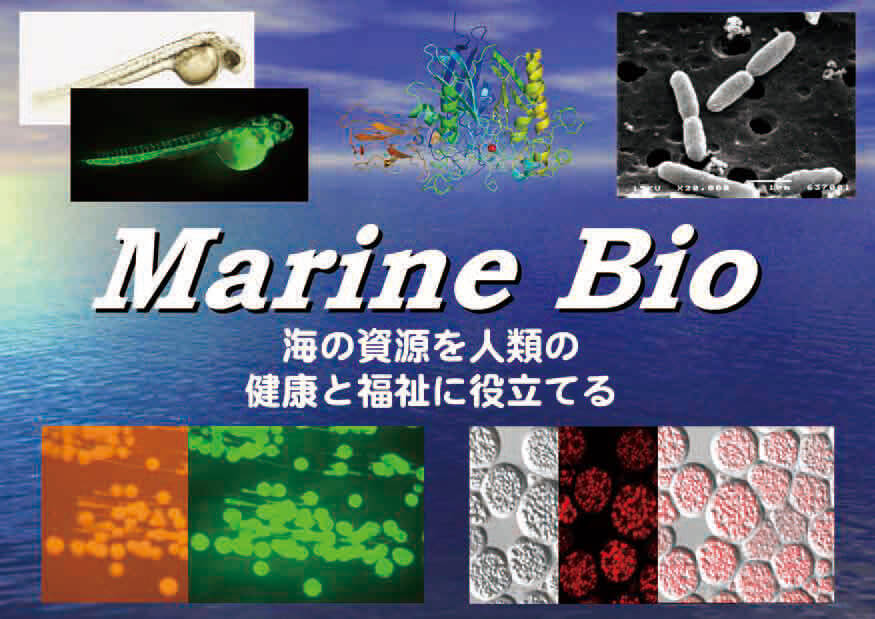
Biological Community Study on Common Eelgrass (Nokonoshima Island)
Seagrass or seaweed communities (i.e., seagrass beds) are important primary production places in coastal zones. They also have the function of purifying water by absorbing nutrient salt. Furthermore, they serve as places to spawn, eat, and hide for other aquatic organisms. Therefore, when these seagrass beds decrease, it is not only a problem in terms of environmental conservation, but also in terms of bioresource conservation. Our laboratories conduct various studies on common eelgrass beds (Zostera marina) to conserve the environment of Hakata Bay. The photo on the left is of a study on fish using a seine and cast net. The one on the right is of an animal community study at night using a light trap. We also conduct studies on shrimp and crab using surrounding nets, and on animal communities during the day using plankton nets, to gather exhaustive data on biological communities that inhabit common eelgrass beds in Hakata Bay.
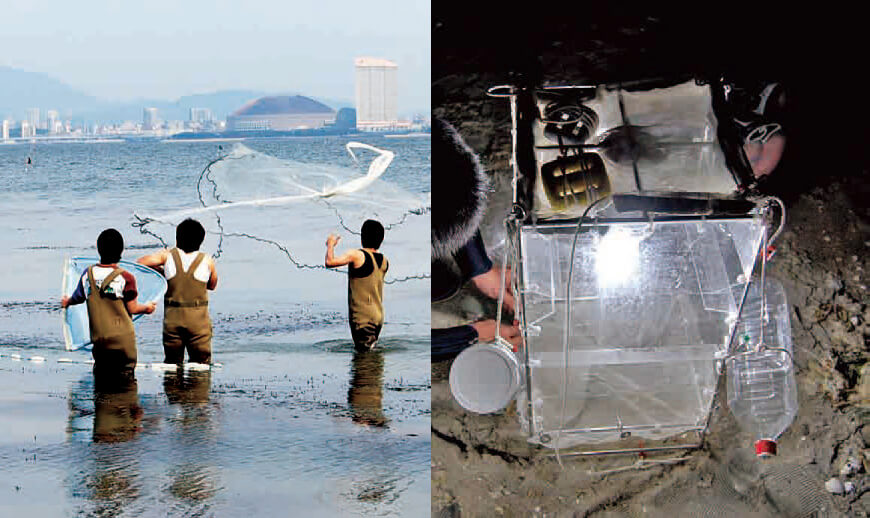
Message from the Director
The hydrosphere, which comprises oceans, rivers, and lakes, covers 70% of the earth’s surface, and plays an important role in the formation and stabilization of the earth’s mild environment. A countless number of organisms—from microorganisms and algae to invertebrates and mammals—inhabit the hydrosphere, and each engages in a wide range of unique biological activities. These organisms are profoundly intertwined with our lives, not only as food resources, but also as pharmaceutical and material resources. However, today the earth’s environment is going through dramatic changes, and the previously stable ocean environment has undergone rapid changes as well. These environmental changes have a huge impact on the distribution and biological production of aquatic animals and plants, and pose a serious threat to Japan, as it is surrounded by ocean and enjoys a wide range of ocean ecosystem services.
The Fisheries Science program fosters experts in life sciences, environmental science, and biotechnology related to aquatic organisms with a cutting-edge and enriching program that encompasses lectures, experiments, and practical courses, and conducts research on undiscovered beneficial bioresources and elucidates living phenomena of the hydrosphere, in order to conserve healthy ecosystems and apply the latent potential of aquatic bioresources to the future of humanity. We are looking for students willing to take bold challenges in research related to the conservation of the hydrosphere—the earth’s last great frontier—and the understanding and sophisticated use of the diverse organisms that inhabit it.Prof. Miki Nakao, Program Director, Fisheries Science

Animal Science
Methods for production of high-quality protein sources, including milk, meat, and eggs, originating from domestic animals
Animal science provides methods for production of high-quality protein sources, including milk, meat, and eggs, originating from domestic animals. Although the remarkable increase in the world’s population requires the effective production of animal products, sustainable production in harmony with the environment is also essential. This research area comprises anatomy, physiology, biochemistry, and biotechnology of domestic and wild animals, aimed at optimized utilization of animal resources, development of animal food processing, evaluation of feed resources, and animal protection.
LABORATORY
Functional Anatomy, Reproductive Physiology, Zoology, Muscle & Meat Sciences, Regulation in Metabolism and Behavior
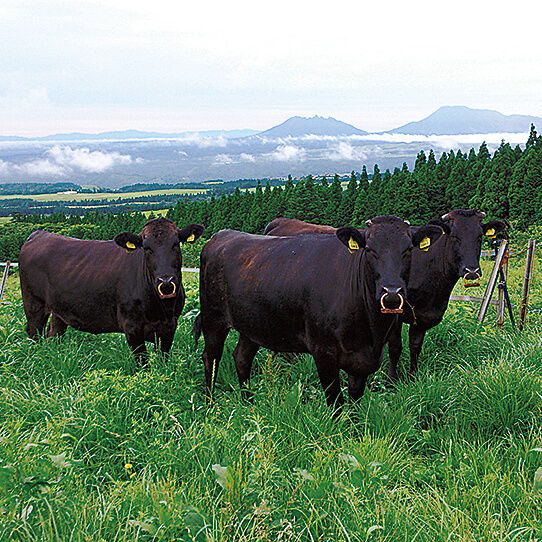
-
More
Analyzing the Pregnancy Recognition Hormone and Uterine Gland Genesis Factor in Bovines
Bovine embryos elongate, forming a thin long shape after breaking out of the zona pellucida (elongated embryo), after which implantation starts. This is a feature of bovine embryos not found in humans and rodents. Early embryonic death in bovines usually happens at this stage, so in order to increase the conception rate, it is important to analyze the pregnancy recognition hormone produced by the elongated embryo and the uterine gland genesis factor which is regulated by progesterone and stimulus from the hormone.

Researching the Mechanisms of Reproductive Cell Formation
We are researching the molecular mechanisms that control reproductive cell formation using a variety of animals and different kinds of stem cells such as pluripotent and sperm stem cells. Our hope is to apply this research to the fields of zoology, animal husbandry, and medicine in areas such as elucidating interspecies diversity and in vitro reproductive cell formation.
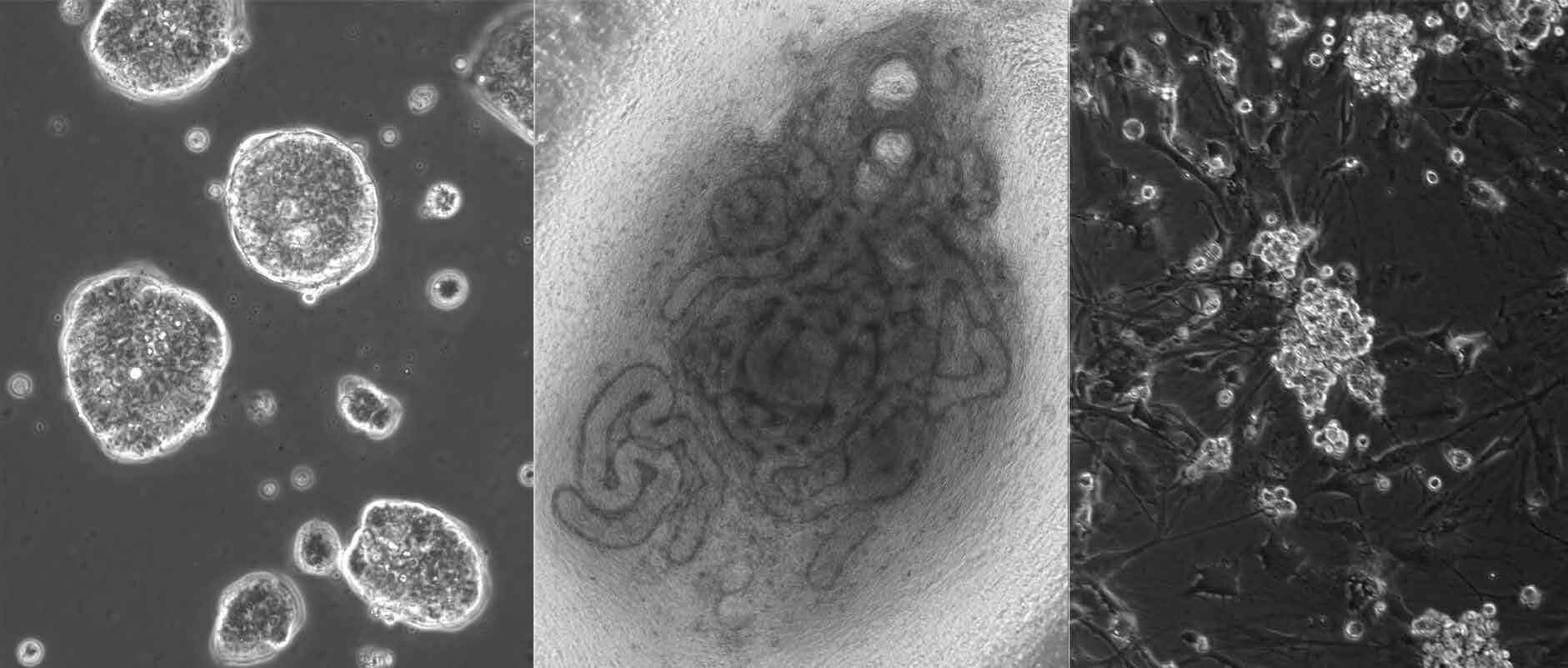
Left: Pluripotent stem cells in culture (ES, iPS cells)
Center: Testicular structure reconstituted in culture
Right: Sperm stem cells in cultureFinding Cattle’s Favorite Grass
The photo is of a practical course on grassland field studies on the Kuju Plateau. Students conduct physiological research on the mechanisms that regulate the amount of feed consumption and the mechanisms of feed digestion in order to improve the effectiveness of cattle feed.
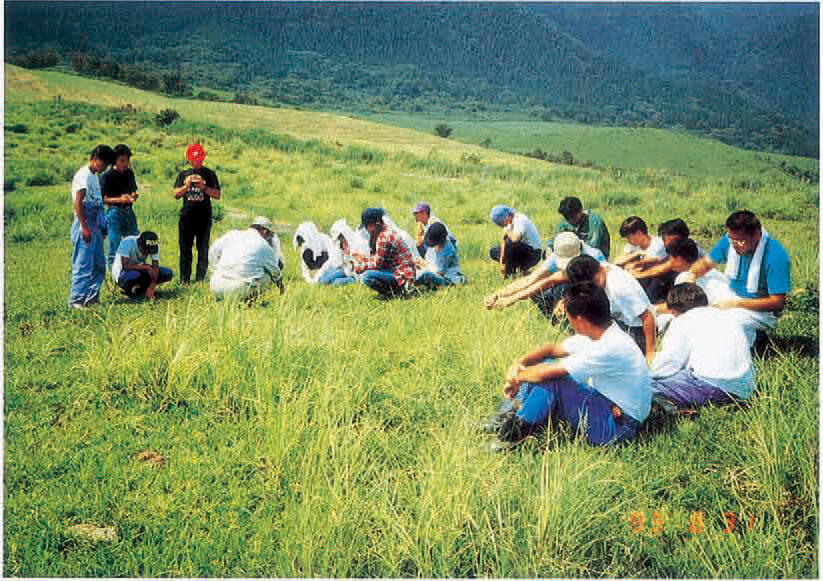
Analyzing Livestock Taste Receptors
We identify taste receptors in ruminants and poultry, and verify what effect their stimulation has on energy metabolism and the quantity of food consumption by observing changes in cells over time with imaging technology (left) and measuring changes in energy metabolism with breath gas analysis (right). We hope to apply this research to animal husbandry industry fields such as feeding.
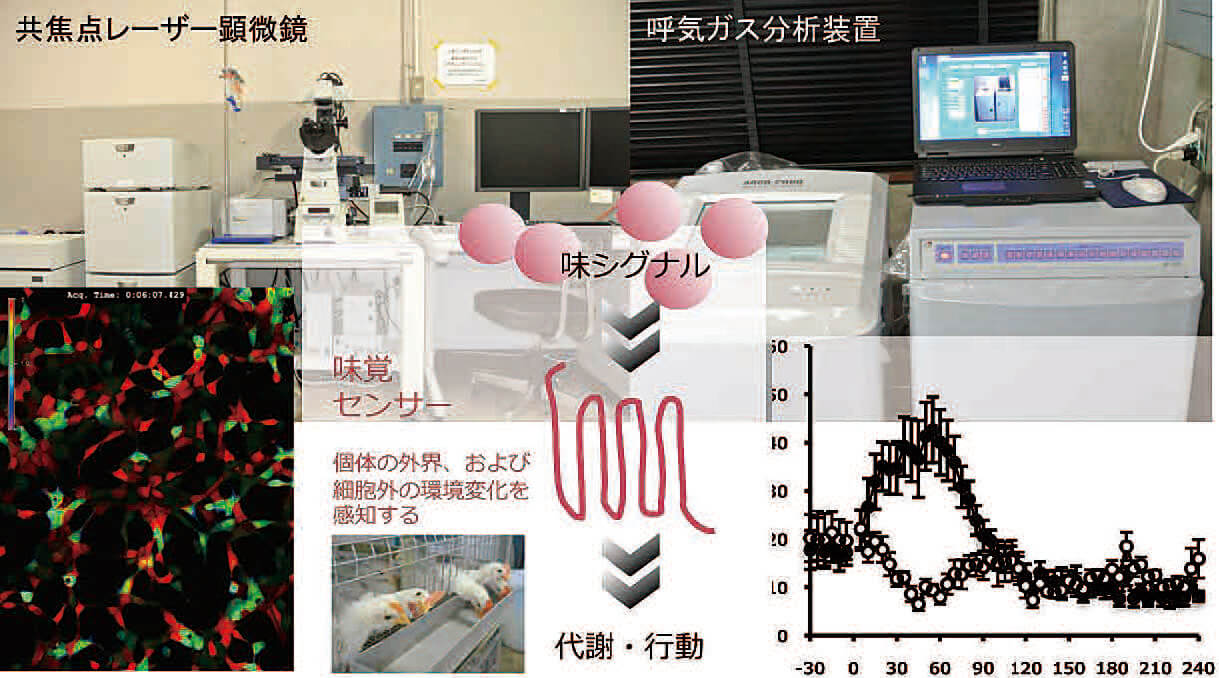
Researching Muscle Hypertrophy, Regeneration, Atrophy, and Phenotypic Modulation
We are conducting research to identify the molecular mechanisms of skeletal muscle hypertrophy, regeneration, atrophy, and modulation in order to maintain and improve physical performance with physical stimulus and food, and boost meat productivity. We hope this basic research can be applied to dietary supplements and pharmaceuticals.
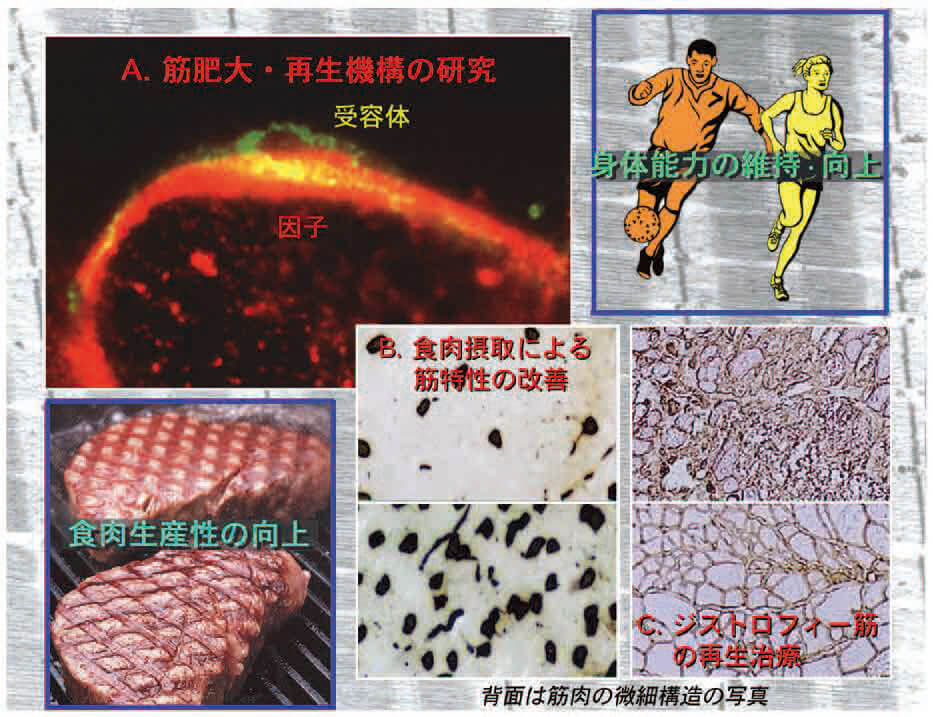
Photo A: Muscles have growth factors and receptors that initiate muscle hypertrophy and regeneration.
Photo B: Consuming meat changes the type of muscle fiber responsible for muscle characteristics.
Photo C: When new growth factors are administered, muscles undergo hypertrophy.Applying Biological Clocks and Seasonal Rhythms to Animal Production and Health Science
We identify the impact of the light‐dark cycle and seasonal cycle on animal behavior, nerves, and metabolism, and search for nutrients that can treat sickness and relieve stress caused by disruptions in the biological clock. We do this by conducting behavior experiments, analyzing body composition with tomographic imaging, fluorescently staining nerve cells, analyzing gene expression, and other means. Our hope is to apply this to the regulation of stress, control of meat productivity, the prevention and treatment of winter depression, and more.
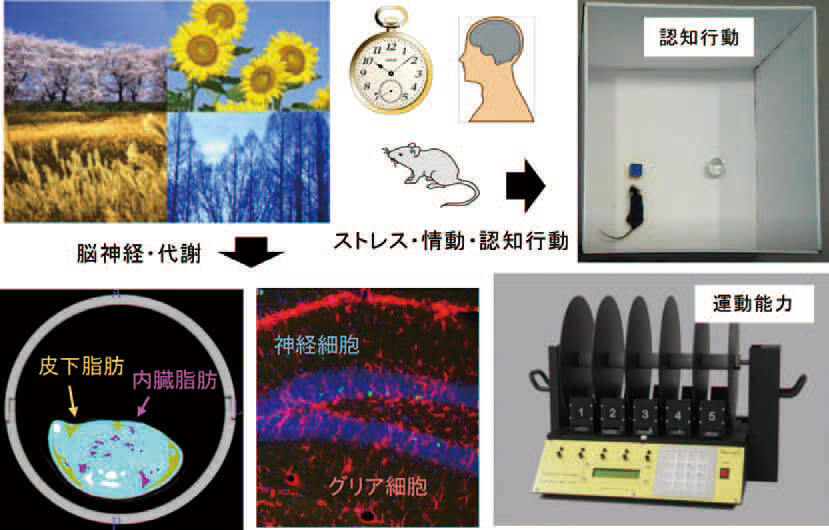
Message from the Director
Meat, milk, and eggs are gifts from terrestrial animals to humanity. Education and research in Animal Science cover the academic disciplines related to such animals. In other words, it spans a wide range of fields: from basic fields related to the mechanisms and functions of animal bodies, birth, and reproduction, to applied fields such as sophisticated use of animal resources, development of functional foods, and evaluation of feed resources. Recently, we have started conducting research with rats and mice laboratory animals) to contribute to human health and to the advancement of science. Many of our graduates have gone on to graduate school. After that they have pursued various careers with a wide range of employers including food companies (recent examples include Itoham and Ajinomoto), animal feed companies (Kyodo Shiryo), pharmaceutical companies (Ono Pharmaceutical, Kobayashi Pharmaceutical), and think tanks (Nippon Steel & Sumikin Research Institute). And of course many graduates still demonstrate their talents as public employees (Ministry of Agriculture, Forestry and Fisheries; Tokyo Metropolitan Government; Fukuoka City Government) and professors (Kyushu University, Kyoto University, Utsunomiya University). Join us to learn about terrestrial animals and research their countless unsolved mysteries.
Prof. Hiroshi Iida, Program Director, Animal Science

Let's Watch!
We have a video that introduces each field and lab to the public.
They have English subtitles, so be sure to check them out!